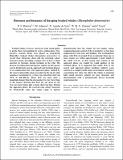Biosonar performance of foraging beaked whales (Mesoplodon densirostris)
Abstract
Toothed whales (Cetacea, odontoceti) emit sound pulses to probe their surroundings by active echolocation. Noninvasive, acoustic Dtags were placed on deep-diving Blainville's beaked whales (Mesoplodon densirostris) to record their ultrasonic clicks and the returning echoes from prey items, providing a unique view on how a whale operates its biosonar during foraging in the wild. The process of echolocation during prey capture in this species can be divided into search, approach and terminal phases, as in echolocating bats. The approach phase, defined by the onset of detectable echoes recorded on the tag for click sequences terminated by a buzz, has interclick intervals (ICI) of 300-400 ms. These ICIs are more than a magnitude longer than the decreasing two-way travel time to the targets, showing that ICIs are not given by the two-way-travel times plus a fixed, short lag time. During the approach phase, the received echo energy increases by 10.4((+/-)2) dB when the target range is halved, demonstrating that the whales do not employ range compensating gain control of the transmitter, as has been implicated for some bats and dolphins. The terminal/buzz phase with ICIs of around 10 ms is initiated when one or more targets are within approximately a body length of the whale (2-5 m), so that strong echo returns in the approach phase are traded for rapid updates in the terminal phase. It is suggested that stable ICIs in the search and approach phases facilitate auditory scene analysis in a complex multi-target environment, and that a concomitant low click rate allows the whales to maintain high sound pressure outputs for prey detection and discrimination with a pneumatically driven, bi-modal sound generator. demonstrating that the whales do not employ range-compensating gain control of the transmitter, as has been implicated for some bats and dolphins. The terminal/buzz phase with ICIs of around 10 ms is initiated when one or more targets are within approximately a body length of the whale (2-5 m), so that strong echo returns in the approach phase are traded for rapid updates in the terminal phase. It is suggested that stable ICIs in the search and approach phases facilitate auditory scene analysis in a complex multi-target environment, and that a concomitant low click rate allows the whales to maintain high sound pressure outputs for prey detection and discrimination with a pneumatically driven, bi-modal sound generator.
Citation
Madsen , P T , Johnson , M , de Soto , N A , Zimmer , W M X & Tyack , P 2005 , ' Biosonar performance of foraging beaked whales (Mesoplodon densirostris) ' , Journal of Experimental Biology , vol. 208 , no. 2 , pp. 181-194 . https://doi.org/10.1242/jeb.01327
Publication
Journal of Experimental Biology
Status
Peer reviewed
ISSN
0022-0949Type
Journal article
Collections
Items in the St Andrews Research Repository are protected by copyright, with all rights reserved, unless otherwise indicated.

